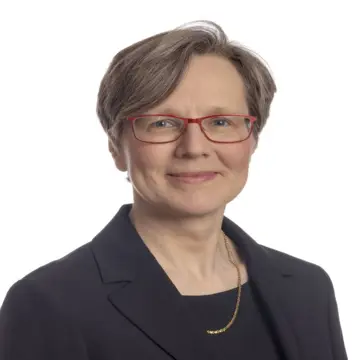Myopia, or short-sightedness, in children and young people is a ‘hot topic’ attracting lots of interest from eye and health care professionals as well as from parents and caregivers.
Following the recent popular webinar on paediatric myopia management, Dr Annegret Dahlmann-Noor answered some of the questions asked by attending healthcare practitioners.
1. Many children use electronic devices at night in a dark room. Could this contribute to the myopia progression? How is this compared to reading a paper book in the dark?
There is increasing evidence that sustained near-focus accelerates myopia onset and contributes to myopia progression. There is no reason to believe that any particular near-vision activity is worse than others. However, as visual information displayed on small screens is smaller than on large screens, increased accommodation/near focus is triggered, and there is an argument that smaller devices may be worse than bigger monitors and screens. The evidence for good room lighting is mounting, and in China work on improving lighting in classrooms is actively pursued.
2. What is the best first line of treatment to slow the progression of myopia in paediatric patients?
The best treatment is the one that the child will use. The leading options currently available in the UK are orthokeratology and soft dual-focus contact lenses, peripheral-plus and diffusion-optics technology spectacle lenses. Which solution may work best for the child/young person and for the parents/caregivers should be discussed during the consultation with the eye care professional.
3. In optical interventions, is the general recommendation for optometrists to not under-correct myopia but give the full (-) found?
There has been increasing evidence that under-correction has no beneficial effect, with some studies finding an associated increase in myopia progression.
4. Is there any clinical evidence of repeated low-level red light (RLRL) therapy stopping the progression of myopia in children?
Randomised controlled trials in China have shown that red-light laser application reduces axial elongation over 1 and 2 years, compared with single-vision spectacle management. There is currently no treatment that stops myopia progression in all children. At present, there are safety concerns about the use of this treatment, though marketing authorisations are in place.
5. Is there any evidence of supplements helping in myopia management?
A healthy, balanced diet is vital for children and young people, but does not slow myopia progression.
6. How can paediatric myopia patients take part in the myopia treatment trials?
Moorfields is a major site for myopia treatment trials, and we are part of a network of UK-wide centres and can provide information and contact details for other trial sites. Our e-mail is moorfields.myopia@nhs.uk – contact us, and we can send you updates on current and upcoming treatment trials.
7. What type of patients do you treat with low-concentration atropine?
Low-concentration atropine is currently only available within the governance framework of selected institutions, and it is not universally available on the NHS. Children tend to get referred to my practice, or parents make direct contact, when progression exceeds what is acceptable to parents and the child’s optometrist, usually despite the use of optical interventions. Less frequently, the young person does not tolerate optical management options and wants to try eyedrops.
8. Can low-concentration atropine be used to treat adults with progressing myopia?
There is increasing evidence that low-concentration atropine can be used in adults to slow myopia progression, but as above, atropine is currently not widely available. Its first on-label indication will be the use in children and young people, where robust clinical trials evidence has demonstrated short- and medium-term efficacy.
9. Are optical/pharmacological myopia interventions effective in children with myopia and other eye pathologies such as congenital stationary night blindness?
All randomised controlled trials only included children with “simple myopia” and excluded those with underlying conditions associated with myopia. However, lack of evidence is not evidence of the lack of an effect. As in all children, the effectiveness of any intervention should be monitored, and if progression continues at the anticipated rate or faster, then the use of the intervention should be critically reviewed.
10. At what age does the myopia progression slow down and when is myopia treatment usually stopped?
The rate of axial elongation slows down with increasing age, in general more so after the age of around 12 years (see excellent charts in the paper referenced below). However, the individual course may be variable and depends on lifestyle, near-work demands, family history etc. It is therefore crucial to monitor progression, ideally by measuring axial length. Once axial elongation has stabilised for 12 months, and when the young person is 15 years or older, the benefits of continuing with myopia management should be discussed with the family. However, this is often the age when studying and exam preparations intensify, and there may well be ongoing benefit from myopia treatment.
References
Logan NS, Wolffsohn JS. Role of un-correction, under-correction and over-correction of myopia as a strategy for slowing myopic progression. Clin Exp Optom. 2020 Mar;103(2):133-137. doi: 10.1111/cxo.12978. Epub 2019 Dec 18. PMID: 31854025.
Bullimore MA, Brennan NA. Juvenile-onset myopia-who to treat and how to evaluate success. Eye (Lond). 2024 Feb;38(3):450-454. doi: 10.1038/s41433-023-02722-6. Epub 2023 Sep 14. PMID: 37709925; PMCID: PMC10858167.

Dr Dahlmann-Noor is an expert in myopia management in children at Moorfields Eye Hospital NHS Foundation Trust and Moorfields Private. She also leads clinical trials and heads a broad portfolio of research studies at Moorfields and University College London and is a frequent speaker at international meetings.
-
Paediatric eye service at Moorfields Private
We are one of the world’s largest specialist children’s ophthalmology centres.
-
Refer your patients to Moorfields Private
Choose world-leading eye care for your patients.
